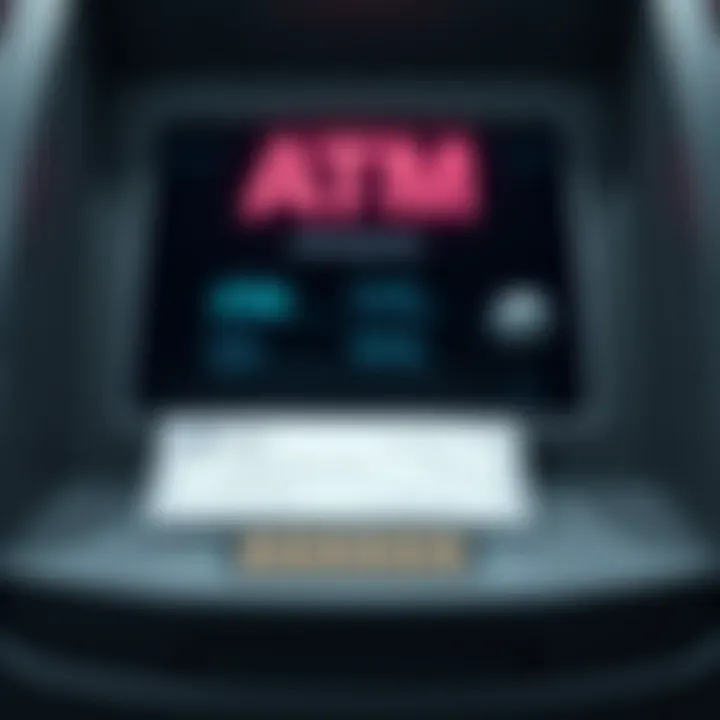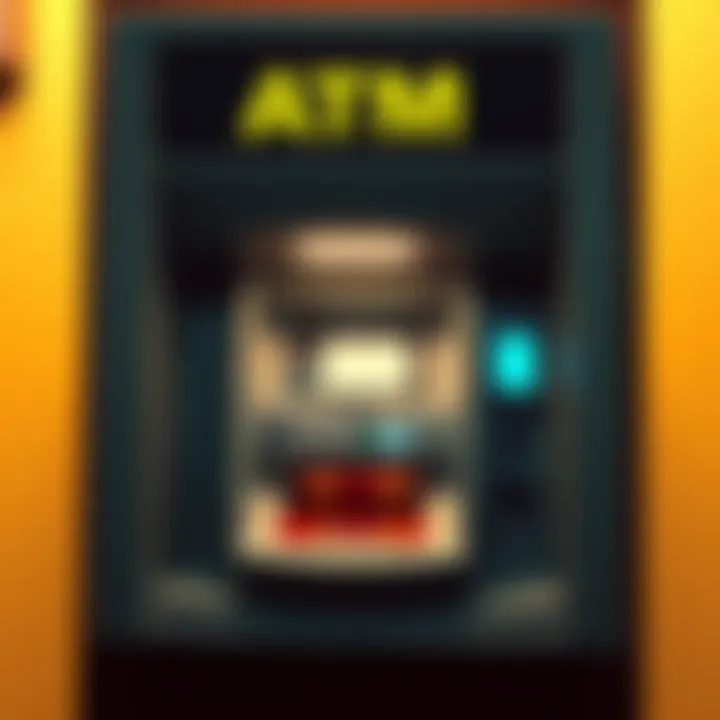Immediate Availability of ATM Check Deposits Explained


Intro
Navigating the intricacies of ATM check deposits can seem like a maze for many consumers. The immediate availability of funds post-deposit is not just a matter of convenience; it ties directly into how we manage our personal finances effectively. Understanding the factors influencing this availability—such as banking regulations, the technological savvy of ATM systems, and the policies specific to financial institutions—can greatly enhance users’ experiences.
The ability to deposit checks via ATM is a lifeline that many rely on. Knowing what to expect, whether your funds will be accessible right away or if some waiting is involved, can make a world of difference in daily budgeting practices. This article aims to unravel these complexities with insights that can arm both new and seasoned users with the knowledge needed to improve their ATM check deposit experiences.
Prelims to ATM Check Deposits
When discussing banking innovations, ATM check deposits represent a significant leap into the realm of convenience. It’s casual for folks to head to an ATM instead of waiting in line at the bank. But beyond just simple convenience, there are intricate elements at play that vary by financial institution, technology used, and even regulatory frameworks. This article will pull back the curtain on how and why immediate availability of those deposits is so relevant today.
The convenience of ATM check deposits isn’t just about dropping a check and walking away. It taps into a broader conversation surrounding financial efficiency and consumer behavior in our fast-paced world. As consumers, we want access to our funds—yesterday if possible. Understanding how these checks are processed not only empowers users but also helps optimize the banking experience.
Moreover, increased ATM usage for deposits correlates with significant shifts in banking practices. From small-town banks to major financial institutions, the way they handle check deposits varies widely. This makes it crucial for both beginners and seasoned investors alike to grasp the policies and technologies that dictate when they can spend their cash.
In essence, a comprehensive understanding of ATM check deposits not only clarifies immediate fund availability but also unpacks the nuances that can govern your banking experience. In the sections to come, we will look at what exactly these deposits are, how their use has grown thus far, and why this matters to your financial journey.
Definition of ATM Check Deposits
ATM check deposits allow bank customers to deposit physical checks into an automated teller machine. This process simplifies what was once a chore requiring bodily presence inside bank branches. Users just need to have their checks, the ATM card, and some basic instructions to get by. Engaging in this kind of transaction means the check goes through a verification process before the funds might be immediately available or held for a specified period.
ATM machines equipped with this function have become increasingly common, allowing for a smoother, more rapid banking experience. Not needing to wait for bank tellers can save significant time. But it’s worth noting that the availability of funds from these deposits can fluctuate based on several factors, which we will explore later.
Growth in ATM Usage for Deposits
As technology pushes us further into a digital-first banking landscape, it’s no surprise that many customers favor ATMs for check deposits. Recent data indicates a steady rise in the number of deposits processed via ATMs. For instance, Bank of America and other large institutions have noted a strong uptick in activity, particularly among Millennials and Gen Z, who prefer the efficiency of digital processes.
Several factors contribute to this notable trend:
- Convenience: The ability to manage money on-the-go without rigid branch hours is a hallmark of modern banking.
- Accessibility: With ATM networks expanding, users can make deposits even in remote areas where a branch might not be available.
- Consumer Preference: A growing aversion to in-person banking, particularly post-pandemic, solidifies the ATM’s role as a pillar of modern finance.
This pivot toward ATM check deposits is a testament to banks adapting to meet evolving consumer needs. Not only does this shift save time and resources for both individuals and the banking institutions, but it also highlights the importance of understanding how these innovations work in relation to fund availability.
How ATM Check Deposits Work
ATM check deposits have become a significant facet of modern banking, offering convenience and flexibility for both everyday consumers and businesses alike. Understanding the mechanics behind how these deposits function can be immensely valuable. Not to mention, knowing the ins and outs offers a strategic advantage when managing funds.
The Check Deposit Process
Depositing a check via an ATM isn't as straightforward as simply sliding your card and pushing a button. The process unfolds in a sequence of steps that are crucial for ensuring that the funds make their way into your account efficiently.
- Initiating the Deposit: First, you approach the ATM, card in hand. After inserting your card and entering your PIN, select the option for check deposits.
- Endorsement Check: One of the first things a deposit should not omit is the endorsement on the back of the check. This is where you sign your name, and it acts as your permission for the bank to process the transaction.
- Inserting the Check: The ATM will instruct you to insert the check, and this is often done face up. Depending on the machine, it may take the entire check or require you to slide it through until it reaches a specific point.
- Image Processing: The ATM will then create a digital image of the check. This step is paramount, as it includes capturing relevant details such as the amount and your account information.
- Verification: Once the ATM processes the check, it sends the image to the bank's systems for verification. This stage includes checking for things like sufficient funds, legitimacy of the check, and correct endorsements.
- Funds Availability: Finally, after passing all checks, the system flags the deposit for fund availability. As we progress through the article, we will touch upon factors that influence this crucial timeline significantly.
Understanding this process not only destigmatizes any previous apprehensions about ATM check deposits but also illustrates the reliance on technology in modern banking. The convenience factor cannot be ignored, as it facilitates transactions long after traditional banking hours.
Technology Behind ATM Deposits
The backbone of ATM check deposits lies in the sophisticated technology that powers these machines. Each ATM is not merely a vault, but rather a complex network of hardware and software working harmoniously.
- Image Capture Technology: Most ATMs are equipped with advanced cameras that snapshot the check as it's deposited. This helps in preserving vital information for processing and enables error reduction, improving accuracy in transaction handling.
- Data Transmission: Once the ATM captures the check, it encodes the relevant information and transmits it back to your bank's servers. This real-time processing is essential for ensuring that your funds are accessible as quickly as possible.
- Security Features: In an age where fraud and identity theft loom large, ATMs are designed with multiple layers of security. Encryption protocols protect sensitive data during transmission and storage, ensuring that your financial information remains secure.
"Security in ATM technology is not just about keeping the money safe; it’s about maintaining the trust placed in financial institutions by customers."
- Software Integration: Most major banks have proprietary software designed to manage everything from deposits to withdrawals and compliances. This ensures that when a check is deposited, all regulatory requirements are met, minimizing risk for the financial institution.
In essence, understanding the technology behind ATM deposits gives consumers the confidence needed to utilize these machines efficiently. It reassures them that their funds are in safe hands, while they relinquish the task of wait times typically experienced in bank queues.
Immediate Availability Explained
The immediate availability of funds from ATM check deposits is an essential topic to grasp, especially in today's fast-paced banking environment. Consumers want to know when they can access their cash without unnecessary delays. Understanding this concept not only saves time but also helps individuals make more informed financial decisions. It directly impacts how quickly transactions can happen, influencing budgeting and spending habits.
Understanding Available vs. Collected Funds
The terms "available funds" and "collected funds" can sometimes be mixed up, but they signify different things in banking. Available funds refer to the portion of your account balance that you can access right away. On the other hand, collected funds are resources that are confirmed to be in your bank balance after a check has cleared.
When you deposit a check via an ATM, only a portion of that amount may be made available immediately. The rest typically takes extra time to clear. This mechanism protects the bank against potential losses from bounce checks.
Understanding this distinction is key for anyone using these services, and it has implications for how we handle our money in the short term.
Factors Affecting Availability Timeline
Several factors come into play when determining how quickly your funds become available after a check deposit.
Check Amount


The check amount plays a significant role in how long you have to wait to access your funds. Larger checks may not be fully available instantly, and banks often impose holds on higher deposits to mitigate risks. This practice isn't merely for the bank's benefit; it's a safeguard for you, the consumer.
What many people may not realize is that even if the checking amount appears as positive in your account, not all of it may be usable. For instance, if you deposit a check for $5,000, you might find only a part becomes available immediately, usually dictated by your bank's policies.
Account History
Your account history carries weight too. If you’ve been a loyal customer with consistent, responsible banking practices, many banks are willing to offer more favorable terms when it comes to check deposits. This can lead to quicker access to funds, which serves as a good incentive for maintaining a healthy banking relationship.
Just a few years of good standing can shift the way banks treat your deposits. In short, the longer you’ve been with them and the fewer mistakes you've made, the more likely they are to allow immediate access to those funds.
Bank Policies
Bank policies differ quite a bit among financial institutions, particularly regarding how long it takes for funds to become available after a check deposit. Some banks may have strict rules that impose holds, especially for checks exceeding certain thresholds. Others might promote customer loyalty with more relaxed hold conditions.
Navigating these policies can be tricky. If you don’t fully understand your bank's regulations, you could end up waiting longer than expected for your funds. It'll do you good to read the fine print or ask a bank representative directly about their specific practices regarding check deposits, so you're in the loop.
Banking Regulations Governing Check Deposits
The complex world of banking regulations is crucial when it comes to understanding how ATM check deposits function. Regulations are not just a dry set of rules; they are designed to protect consumers and standardize banking practices across institutions. This section will delve into the regulatory landscape governing check deposits, providing insights into benefits and key considerations that both consumers and financial institutions must navigate.
Regulatory Framework Overview
Banking regulations encompass a range of laws and guidelines that financial institutions must follow. These regulations are not just a formality; they exist to maintain trust in the financial system. The primary purpose is to ensure a safe and sound banking environment, protect consumer rights, and foster fair competition among banks.
In the United States, one of the biggest frameworks governing check deposits is the Federal Reserve’s Regulation CC. It outlines the availability of funds and the terms under which check deposits must be handled. Let’s break down what that means:
- Consumer Protections: Regulation CC ensures that consumers have access to their deposited funds in a timely manner. This regulation specifies how quickly a bank must make funds from deposited checks available to the account holder.
- Transparency: Banks are required to provide clear disclosures regarding their policies on fund availability. This is crucial so consumers aren't left guessing about when their money will be accessible.
- Standardization: Regulations help create a level playing field. This means that no matter where you deposit your check, the rules governing the availability of those funds are consistent across banks.
In summary, understanding this regulatory framework is vital not just for banks but also for consumers who need to be aware of their rights and obligations.
Regulation and Its Impact
Regulation CC is a linchpin in the landscape of ATM check deposits. It governs how quickly funds from deposited checks must become available for withdrawal or other uses. It influences several aspects, including:
- Availability Schedules: The regulation outlines specific timeframes when banks must make funds available depending on the type and amount of the check.
- Identification of Check Types: Not all checks are treated equally under Regulation CC. Certain checks, like checks drawn on federal credit unions, might require stricter rules and longer timelines before funds are available.
- Impact on Consumers: As a consumer, knowing the ins and outs of Regulation CC can guide your decisions. If you're frequently relying on ATM check deposits, understanding when your funds will be accessible can help you budget better and avoid potential overdrafts.
- For instance, a customer depositing a local check usually has access to some of the funds the next business day.
- Larger checks or those from out of state might have different schedules, which can lead to delays.
- This knowledge also aids in planning for larger purchases if you know when your full deposit will clear.
In essence, Regulation CC plays a significant role in shaping the ATM deposit experience, balancing the needs of consumers for prompt access to their funds with the bank's needs to manage risk effectively.
"Knowing the rules of the road can save a lot of headaches later on."
Understanding these regulations not only empowers consumers but also helps banks operate within a framework that fosters trust and security. In the next sections, we will explore specific policies from different financial institutions, which will showcase how these regulations are interpreted and applied in real-world scenarios.
Comparative Analysis of Major Financial Institutions
When it comes to ATM check deposits, every bank and credit union has its own set of policies. A comparative analysis of major financial institutions sheds light on how these differences can impact a consumer's depositing experience. Understanding these variations is crucial for making informed decisions about where to bank and which financial products align best with individual needs.
Each bank brings its own philosophies and frameworks to the table, driven by factors such as regulations, risk assessment, and technology adoption. For instance, some banks may prioritize immediate availability of deposited funds to enhance customer satisfaction, while others may implement stricter policies to mitigate risk. The implications of these policies can be significant for users, especially when considering the urgency of accessing funds.
Bank A: Policies on Immediate Availability
Bank A has positioned itself as a frontrunner in customer-centric banking practices, implementing policies that favor immediate availability of funds for check deposits. Deposits made before a cut-off time may see funds available on the same day, a distinct advantage for those who require quick access. This policy is particularly appealing for consumers who operate within tight financial timelines.
To further understand their approach, it’s important to note:
- Technology Integration: Bank A employs advanced image capture technology to process checks faster.
- Risk Assessments: Their system uses predictive analytics to minimize risk while expediting fund availability.
- Customer Service Focus: They encourage customers to communicate any urgent needs directly, allowing for personalized assistance even in automated systems.
Bank B: Deposit Timing and Restrictions
Turning to Bank B, the scene shifts somewhat. While they do offer competitive services, their deposit timings and restrictions can sometimes lead to frustration among customers. Deposits made at specific hours may only be available the next business day, a limitation that could hinder those with pressing financial requirements.
Consider the following points regarding Bank B:
- Cut-off Times: Deposits made after 3 PM are not processed until the next day, affecting immediate fund accessibility.
- Limitations on Amounts: Higher amounts may be subjected to longer hold times, adding another layer of delay.
- Variances in Policies: If customers use ATMs from other networks, they might encounter differing availability timelines contrary to those offered at their primary institution.
Bank C: Unique Features of Check Deposits
Finally, Bank C captivates with several unique features in its check deposit offerings. This institution embraces innovation and recognizes the importance of user experience. They combine flexibility and technology, providing customers with options tailored to individual needs, which may influence immediate availability.
Unique aspects to highlight include:


- Instant Mobile Deposits: Bank C allows users to deposit checks through their mobile app with immediate fund access, making it convenient for tech-savvy customers.
- User-Friendly Interface: Their ATM check deposit interface is designed with simplicity in mind, making the deposit process quick and painless.
- Feedback Mechanisms: Customers can provide feedback on their deposit experiences, which Bank C actively uses to refine its services.
In examining these institutions, consumers gain insight into how different policies and features can affect their banking experience. As ATM technology and user expectations evolve, staying informed about these comparisons can lead to better banking choices.
"Choosing the right bank isn't just about fees and rates; it's about understanding how their policies will affect you when you need money the most."
For further insights on banking policies and consumer rights, you can visit Consumer Financial Protection Bureau or explore Investopedia for more on the financial sector.
Common Issues with ATM Check Deposits
When engaging with the world of ATM check deposits, understanding the common issues that arise is paramount. This section serves to spotlight the typical complications that might unexpectedly hinder a seamless depositing experience. Grasping these challenges not only prepares users but also empowers them to mitigate potential hindrances, ultimately enhancing their banking efficiency.
Delayed Availability Explained
One of the primary concerns people face when utilizing ATM check deposits is the issue of delayed availability. Even though you might see that the deposit has gone through, it does not always mean that the funds are ready for instant use. This delay can stem from various factors including the bank’s own policies, the time of day the deposit was made, or the check itself.
For instance, if you deposit a check late in the day or on a holiday, the funds might not be processed until the next business day. Hence, while it can feel frustrating to wait for access, it's often in the hands of banking protocols that are designed to protect both the institution and the user from fraud and errors. Understanding these timelines can help users better plan their finances.
Mistakes to Avoid When Depositing
The realm of ATM check deposits is not without its potential pitfalls. Here are a couple of aspects where mistakes might happen, leading to unnecessary delays or complications.
Incorrect Endorsements
One area that can cause significant trouble is incorrect endorsements. This refers to when a depositor fails to endorse a check properly before attempting to deposit it. The endorsement should generally include the signature of the payee and sometimes a specific message that allows automatic processing.
A key characteristic of incorrect endorsements is that it can result in the bank rejecting the deposit altogether. This mistake can lead to funds not being available when needed most and might require additional trips back to the ATM or even to a bank branch. The hassle of rectifying this situation may also consume valuable time, which is why proper endorsement is crucial. It is generally beneficial for users to double-check endorsements beforehand.
Deposit Amount Errors
Another common issue comes in the form of deposit amount errors. This occurs when a user miskeys the amount they intend to deposit into the ATM. Such mistakes can be particularly problematic if the discrepancy is significant, leading to a mismatch between the written amount on the check and the entered amount.
The key characteristic of deposit amount errors is that they can delay the processing of the deposit, or worse, create discrepancies in account balances. It can also necessitate a follow-up with the bank to resolve the issue, which can be time-consuming and potentially lead to frustration. Thus, it's highly advisable for users to carefully review the amount entered before finalizing the deposit. A common practice is to keep a personal record of the intended deposit to cross-reference and ensure accuracy.
"Preventing deposit issues is always better than resolving them later on."
By being aware of these common challenges and taking the proper steps to avoid them, users can ensure a smoother and more efficient ATM check deposit experience.
Maximizing Your ATM Deposit Experience
In today's fast-paced world, banking has become more convenient, making ATM deposits a preferred option for many. But, to truly benefit from this service, individuals must understand how to maximize their ATM deposit experience. The significance of this topic lies in empowering consumers with knowledge that can lead to quicker access to funds, reduced errors, and a smoother banking process overall.
Best Practices for Depositing Checks
When it comes to depositing checks at ATMs, there are several best practices that can enhance your experience:
- Confirm ATM Functionality: Before you initiate a deposit, ensure the ATM supports check deposits. Not all machines have this functionality.
- Use Established Machines: Stick to ATMs owned by your bank or trusted providers. Some third-party machines could impose additional fees or restrictions.
- Prepare the Check: Endorse the back of the check correctly and ensure all information is clear and legible. A smudged or unclear check can lead to deposit failures.
- Follow ATM Instructions: Each machine may have different prompts. Taking the time to read on-screen instructions can prevent mistakes.
- Keep Records: After making a deposit, always take a transaction receipt. This serves as proof and allows for tracking if any discrepancies arise.
Thanks to these simple steps, your ATM check depositing can actually be a breeze; they help streamline the process and minimize the chance of mishaps.
Understanding Deposit Limits
Awareness of deposit limits is crucial to fully capitalizing on your ATM deposit experience. Banks often impose limits on how much you're able to deposit at any one time or within a specified period. Here are a few key points:
- Daily Limit: Most banks cap the total amount you can deposit in a day at their ATMs. This varies by institution, so check ahead to avoid surprises.
- Check Amount Limitations: Some banks may set limits on individual check amounts as well. Familiarizing yourself with these amounts helps ensure that you’re not caught off guard.
- Regulatory Requirements: Adhering to banking standards is critical. Certain regulations may mandate limits designed to mitigate fraud risks, which can affect how much you deposit.
It’s wise to analyze your bank’s terms regarding deposit limits, as this knowledge can help in planning your deposits effectively, ensuring you're not facing unnecessary delays in fund availability.
"Understanding the rules can provide the upper hand when managing your funds."
In summary, maximizing your ATM deposit experience hinges on being informed and prepared. The routines of endorsing checks properly, knowing your bank's limits, and selecting the right ATM can dramatically enhance your banking efficiency. Doing so allows both novice and experienced users to navigate the landscape of ATM deposits with ease.
Alternatives to ATM Check Deposits
When it comes to handling check deposits, especially in the digital age, having alternatives to ATM check deposits is crucial. These alternatives not only provide flexibility but also enable consumers to make informed choices based on their specific needs and circumstances. In this section, we will explore the primary alternatives: mobile check deposits and traditional in-branch deposits, discussing their benefits and considerations in detail.
Mobile Check Deposits
Mobile check deposits have emerged as a prime alternative to ATM check deposits, allowing users to deposit checks using their smartphones or tablets. This process is generally quick and user-friendly, often involving just a few taps on a screen. Here’s how it works:
- Capture an Image: Users take a photo of the front and back of the check they want to deposit.
- Provide Details: After the image is captured, the app often requires the user to enter the deposit amount.
- Submission: Finally, users submit the deposit through their banking app.
The benefits of using mobile check deposits include:


- Convenience: Depositing a check can happen anywhere, anytime. No more hassle of finding an ATM or banking hours.
- Speed: Mobile check deposits are often processed quickly, sometimes with quicker access to funds than ATM deposits.
- User Friendly: Most banking apps are designed with the user in mind, making the process straightforward and intuitive.
However, there are a few considerations to keep in mind:
- Daily Limits: Many banks place daily limits on the amount you can deposit through mobile apps, which can stall larger transactions.
- Deposit Holds: Just like with ATM deposits, mobile deposits may be subject to holds, delaying access to funds, especially for new account holders.
In-Branch Deposits: Feasibility and Timing
In-branch deposits represent a traditional approach to check depositing, where customers physically visit their bank's branch to complete the transaction. While this may seem less convenient in our fast-paced world, it does have its own set of perks.
The advantages of in-branch deposits include:
- Immediate Confirmation: Depositors receive immediate confirmation that the deposit was accepted, reducing uncertainty.
- More Expedited Processing: In some cases, checks can be available faster than through ATMs, especially for accounts in good standing.
- Personal Assistance: Bank staff members are readily available to assist with any issues or inquiries regarding the deposit.
Nevertheless, there are drawbacks associated with this method:
- Time Consumption: This option usually requires a time investment, as waiting in line during busy hours can be tedious.
- Limited Accessibility: For those in rural areas or with inflexible schedules, banking hours may not align with personal availability.
Both mobile check deposits and in-branch deposits present valuable alternatives to ATM check deposits. Your choice may depend on your urgency, the amount involved, and personal preferences. Exploring these options helps ensure you choose the most appropriate channel for your banking needs.
"In a world where convenience drives consumer choices, understanding the alternatives to ATM check deposits can pave the way to more effective banking strategies."
For further reading on the different banking methods, you might find these resources helpful: Wikipedia on Banking, Investopedia on Mobile Banking, Consumer Financial Protection Bureau.
Being aware of all these alternatives empowers you to make well-informed banking decisions.
Future Trends in ATM Check Deposits
Understanding the future landscape of ATM check deposits isn’t just about peering through a crystal ball; it's about analyzing current trends and anticipating what lies ahead. As technology interweaves itself deeper into our banking practices, the implications for check deposits at ATMs are profound. The significance of these trends is both practical and transformative, influencing how individuals interact with their finances.
Technological Advancements in ATMs
Advancements in technology are enhancing the functionality of ATMs beyond simple cash withdrawal. With innovations like remote deposit capture and integrated verification systems, the traditional ATM is evolving into a highly efficient banking tool. By leveraging high-resolution imaging technology, ATMs can accurately scan checks, mitigating errors that were commonplace in earlier models.
Benefits of Technological Advancements:
- Speed: Checks can be processed faster, leading to quicker availability of funds.
- Security: Enhanced verification processes reduce the risk of fraud, making deposits safer for users.
- User Experience: Features like touchscreen interfaces and multilingual support cater to a broader demographic, making banking more accessible.
These improvements mean that in the near future, the check deposit process could be almost instantaneous, making waiting times a thing of the past. It is crucial for users to stay informed about these technological shifts, as they will directly impact how and when funds become available.
Evolving Banking Practices
As technology pushes the boundaries, banking institutions are concurrently reassessing their strategies regarding ATM check deposits. The shift towards a digital-first approach is notable, with banks focusing on providing enhanced customer service through ATMs that offer more than just check deposits.
Some significant evolutions in this realm include:
- Increased Automation: Banks are starting to employ smart ATMs that can handle a broader range of transactions without requiring human intervention.
- Real-Time Updates: As banking apps grow in sophistication, connectivity between ATMs and bank systems means that users can receive real-time information about deposit statuses and availability.
- Customized Services: Institutions are utilizing data analytics to offer personalized ATM experiences, based on individual usage patterns.
Moreover, policies that guide deposit availability are becoming more flexible as well. Banks are increasingly recognizing the need for adaptable practices that reflect customer expectations, which can potentially encompass immediate fund access without lengthy holds.
"As technology advances, both banks and customers must keep pace, ensuring that ATM capabilities align with modern banking needs."
The future of ATM check deposits seems primed for exciting changes. As both technology and banking practices progress, users are likely to see safer, faster, and more efficient methods for managing funds. Keeping an eye on these trends can empower individuals to navigate their financial worlds with greater ease and confidence.
For detailed regulations, visit the Federal Deposit Insurance Corporation or Consumer Financial Protection Bureau.
Stay updated by checking resources like Wikipedia and financial discussions on platforms like Reddit for community insights.
Ending
The topic of immediate availability of ATM check deposits is a crucial aspect for both bank customers and financial institutions. Understanding the intricacies of how quickly funds become accessible can make a world of difference in personal finance management. For instance, a delayed check deposit can lead to bounced checks or an unexpected financial crunch.
In this article, we explored not just the operational side of ATM check deposits but also the various layers of regulations and technologies that make these transactions possible. The importance of knowing how available versus collected funds work cannot be overstated. It impacts day-to-day finances significantly. When withdrawing cash, consumers need to comprehend which funds they can access immediately and which will require a waiting period.
The nuances of bank policies are also key players in this game. Each institution approaches the availability of funds differently, influenced by its own regulations and evaluation criteria. These factors, including account history and check amount, ultimately dictate how long a person waits after making a deposit.
So what does this mean for the average consumer? Understanding these variables helps in planning short-term and long-term financial strategies. It reduces anxiety when expecting urgent funds and enables more informed decision-making.
Finally, as ATM technology advances, the potential for improved deposit experience grows. Staying informed about upcoming trends, alongside current practices, equips consumers with the tools to navigate the ATM check deposit landscape more efficiently.
Being smart about check deposits translates into better financial health in the long run.
Final Thoughts on ATM Check Deposits
In summary, ATM check deposits serve a vital purpose in modern banking. They provide convenience, but with that comes the responsibility to understand what happens behind the scenes. There is a lot at stake when it comes to immediate availability. Considering all these aspects can enable consumers to navigate their banking needs strategically.
When using ATM services for check deposits, remember to:
- Review bank policies: Familiarize yourself with your institution's specific rules for immediate availability.
- Understand your rights: Stay informed about consumer protection laws that may apply, like Regulation CC in the United States.
- Monitor your transactions: Keep track of deposit timings and verify your balance afterward to ensure everything checks out.
In essence, taking a proactive stance regarding ATM check deposits not only enhances an individual's banking experience but also lays the groundwork for stronger financial management in the future. By grasping these concepts, individuals equip themselves to face banking tasks with confidence and clarity.







